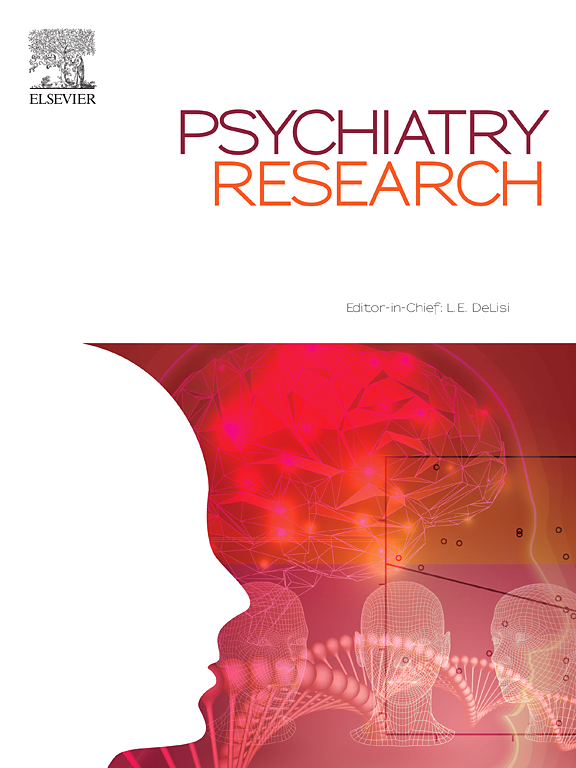精神科住院病人出院后自杀:回顾性病例对照研究
IF 3.9
2区 医学
Q1 PSYCHIATRY
引用次数: 0
摘要
背景与目的精神病院出院后的一段时间与高自杀风险相关。本研究旨在确定加拿大安大略省出院后自杀的比率和相关危险因素。方法本回顾性病例对照研究的时间跨度为2006-2018年,利用安大略省的数据,将出院后7天、30天和90天内自杀死亡的患者与对照组进行比较。比较临床、人口统计学和医疗保健利用因素。采用Cox比例风险模型确定与自杀相关的独立因素。结果在615067名精神病出院患者中,在7天、30天和90天内分别有320人、771人和1325人自杀死亡。这些死亡人数对应的自杀率分别为每10万人年2713、1525和882人,每1000名出院人员自杀率分别为0.52、1.25和2.15人。病例多为男性,年龄在45-54岁之间,涉及计划外出院和自杀行为史,并因情绪或适应障碍而入院。农村居住、收入、医疗合并症、酒精、物质使用障碍和精神疾病与自杀无显著相关性。医疗保健服务利用率无显著差异。结论出院后自杀率最高,并在出院后90天内保持高于加拿大一般人群的自杀率。确定的危险因素包括情绪障碍、男性、中年、住院时间较短和计划外出院——与之前的工作一致。计划外出院和住院时间较短的患者可能需要更密切的随访以降低风险。本文章由计算机程序翻译,如有差异,请以英文原文为准。

Suicide following discharge from inpatient psychiatric care: A retrospective case control study
Background and Aims
The period following discharge from psychiatric hospitalization is associated with high suicide risk. This study sought to determine the rate and associated risk factors of individuals who die by suicide after discharge in Ontario, Canada.
Methods
This retrospective case-control study, spanning from 2006-2018, utilized Ontario data to compare individuals who died by suicide within 7, 30, and 90 days of discharge with controls. Clinical, demographic, and healthcare utilization factors were compared. A Cox proportional hazards model was utilized to determine factors independently associated with suicide.
Results
Across 615,067 psychiatric discharges, there were 320, 771, and 1325 suicide deaths within a 7-, 30-, and 90-day period respectively. These deaths correspond to a suicide rate of 2713, 1525, and 882 deaths per 100,000 person-years and 0.52, 1.25, and 2.15 suicides per 1000 discharged individuals. Cases were more likely to be male, aged 45-54, involve unplanned discharge and a history of suicidal behaviour, and admitted for mood or adjustment disorders. Rural residence, income, medical comorbidity, alcohol, substance use disorder, and psychotic illness were not significantly associated with suicide. Healthcare service utilization did not differ significantly.
Conclusions
The suicide rate is highest immediately following discharge and remains elevated above that of the general Canadian population throughout the 90 days afterward. Risk factors identified include mood disorders, male sex, middle age, shorter length of stay, and unplanned discharge - consistent with previous work. Individuals with unplanned discharges and shorter lengths of stay may be good candidates for closer follow-up to mitigate risk.
求助全文
通过发布文献求助,成功后即可免费获取论文全文。
去求助
来源期刊

Psychiatry Research
医学-精神病学
CiteScore
17.40
自引率
1.80%
发文量
527
审稿时长
57 days
期刊介绍:
Psychiatry Research offers swift publication of comprehensive research reports and reviews within the field of psychiatry.
The scope of the journal encompasses:
Biochemical, physiological, neuroanatomic, genetic, neurocognitive, and psychosocial determinants of psychiatric disorders.
Diagnostic assessments of psychiatric disorders.
Evaluations that pursue hypotheses about the cause or causes of psychiatric diseases.
Evaluations of pharmacologic and non-pharmacologic psychiatric treatments.
Basic neuroscience studies related to animal or neurochemical models for psychiatric disorders.
Methodological advances, such as instrumentation, clinical scales, and assays directly applicable to psychiatric research.
 求助内容:
求助内容: 应助结果提醒方式:
应助结果提醒方式:


